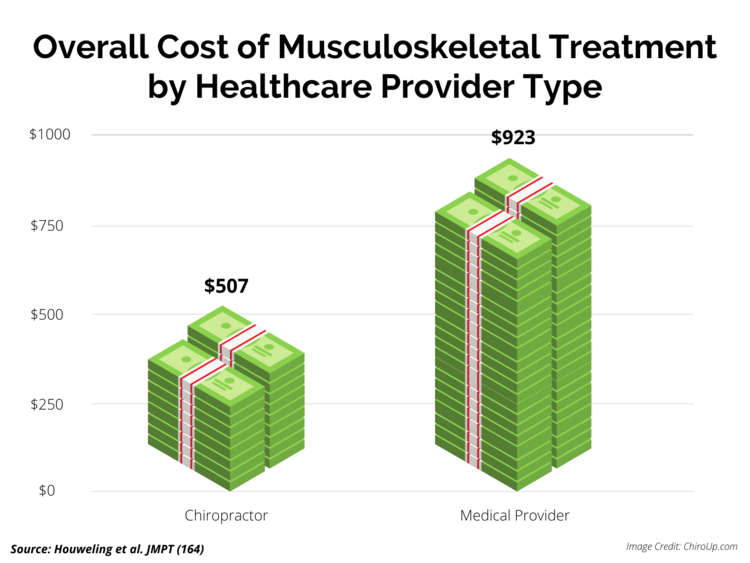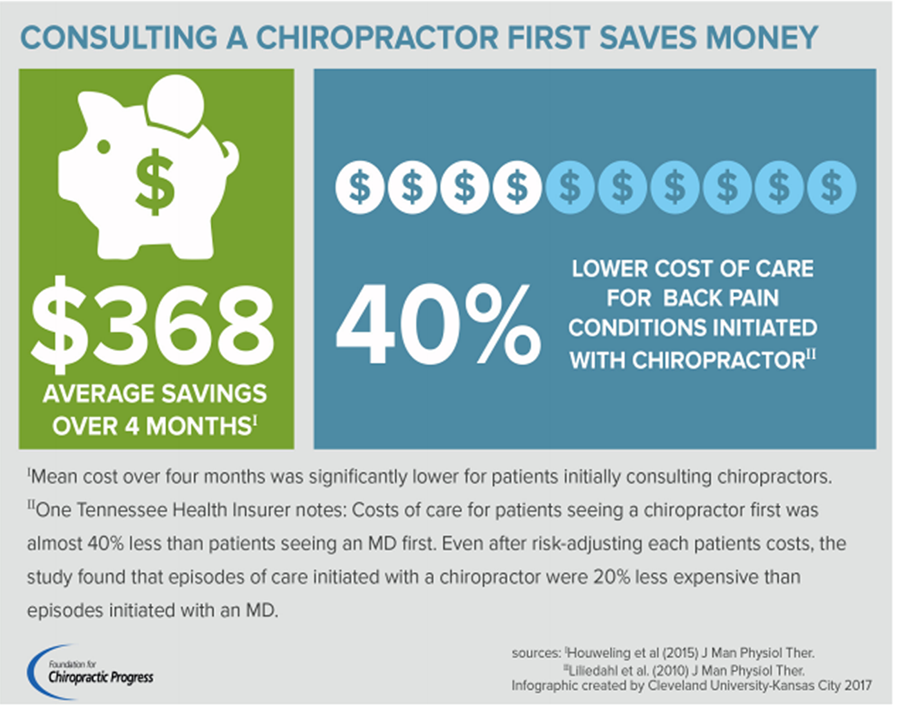Cost of Chiropractic Versus Medical Management of Adults with Spine-related Musculoskeletal Pain: A Systematic Review
SOURCE: Chiropractic & Manual Therapies 2024 (Mar 6); 32: 8
| OPEN ACCESS |
Ronald Farabaugh • Cheryl Hawk • Dave Taylor • Clinton Daniels • Claire Noll • Mike Schneider • John McGowan • Wayne Whalen • Ron Wilcox • Richard Sarnat • Leonard Suiter • James Whedon
American Chiropractic Association,
2008 St. Johns Avenue,
Highland Park, Illiois. 60035
Arlington, VA, USA.

FROM: Houweling, JMPT 2015
Background: The cost of spine-related pain in the United States is estimated at $134.5 billion. Spinal pain patients have multiple options when choosing healthcare providers, resulting in variable costs. Escalation of costs occurs when downstream costs are added to episode costs of care. The purpose of this review was to compare costs of chiropractic and medical management of patients with spine-related pain.
Methods: A Medline search was conducted from inception through October 31, 2022, for cost data on U.S. adults treated for spine-related pain. The search included economic studies, randomized controlled trials and observational studies. All studies were independently evaluated for quality and risk of bias by 3 investigators and data extraction was performed by 3 investigators.
Results: The literature search found 2256 citations, of which 93 full-text articles were screened for eligibility. Forty-four studies were included in the review, including 26 cohort studies, 17 cost studies and 1 randomized controlled trial. All included studies were rated as high or acceptable quality. Spinal pain patients who consulted chiropractors as first providers needed fewer opioid prescriptions, surgeries, hospitalizations, emergency department visits, specialist referrals and injection procedures.
There is more like this @
COST-EFFECTIVENESS Section and the
SPINAL PAIN MANAGEMENT Section and the
Conclusion: Patients with spine-related musculoskeletal pain who consulted a chiropractor as their initial provider incurred substantially decreased downstream healthcare services and associated costs, resulting in lower overall healthcare costs compared with medical management. The included studies were limited to mostly retrospective cohorts of large databases. Given the consistency of outcomes reported, further investigation with higher-level designs is warranted.
Keywords: Chiropractic; Conservative care; Healthcare costs; Healthcare utilization; Low back pain; Manipulation; Opioids; Spinal.
From the FULL TEXT Article:
Introduction
Spine-related musculoskeletal pain is the leading cause of disability worldwide and one of the most common reasons for missed work. [1] In the United States (U.S.), healthcare costs for low back and neck pain are rising and as of 2016 were the highest for any condition, with an estimated $134.5 billion for care related to spinal pain. [2]
There are many options for treatment of acute or chronic spine-related pain. These range from conservative therapies, such as manual or behavioral therapies, to medications, injection procedures and surgery. [3, 4] Approaches to management of spine-related musculoskeletal pain differ by type of provider, such as chiropractors, physical therapists, primary care medical physicians and medical specialists such as orthopedists and neurologists. [5] In the U.S., chiropractic care is one of the most commonly utilized approaches to treatment of spine-related musculoskeletal pain. [6] Chiropractic care guidelines are concordant with the American College of Physicians’ recommendations for initial management of low back pain (LBP) using non-pharmaceutical treatment. [7, 8]
In the midst of rising healthcare costs, it is important to examine not only clinical outcomes but also the cost of intervention strategies for spine-related pain. Although most cases of spine-related musculoskeletal pain can be effectively managed with conservative guideline-concordant non-pharmacological and non-invasive approaches, frequently a patient’s course of care is unnecessarily escalated by use of more invasive, hazardous, and/or costly procedures. [9] The escalation of care for spine-related musculoskeletal pain may include emergency department visits, medical specialist visits, diagnostic imaging, hospitalization, surgery, interventional pain medicine techniques, prescription of drugs with high risk for addiction or abuse, and encounters for complications of spine care (e.g., adverse drug events). [9] The escalation of spine-related musculoskeletal pain management is closely associated with increased downstream costs.
Gold et al. defined “downstream” costs as those that “may have changed, intentionally or unintentionally, as a result of the implementation strategy and intervention.” [10]p.3 Downstream costs may include those associated with healthcare utilization, patient and caregiver costs, productivity costs and costs to other sectors. For spine-related musculoskeletal pain, most often LBP, an emerging body of evidence suggests that downstream costs are significantly affected by the specialty of the initiating care provider. [5] Such costs typically include diagnostic tests, particularly advanced imaging [11], surgery,
The opioid epidemic. For patients with spine-related musculoskeletal disorders, among the most important escalations of care associated with downstream human and societal costs that are receiving recent attention are opioid use, abuse and overdose. In 2017, the U.S. government declared the opioid epidemic to be a Public Health Emergency. [13] This epidemic is still on the rise, with drug overdose deaths increased by 31% in a single year, 2019–2020. [14]
It is not certain which combination of provider and/or therapy offers the most cost-effective approach to managing spine-related musculoskeletal pain. A 2015 systematic review compared the costs of chiropractic care to those of other types of health care. [15] The costs were generally lower when musculoskeletal spine care was managed by chiropractors, though the included studies contained methodological limitations. [15] The purpose of this review was to update, summarize, and evaluate the evidence for the cost of chiropractic care compared to conventional medical care for management of spine-related musculoskeletal pain. [15]






Leave A Comment